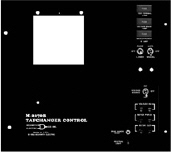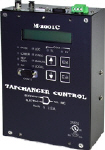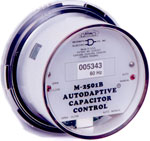|

Adapter Panels
Beckwith's digital tapchanger control line is the latest concept in replacements by using a single tapchanger control - the M-2001 series - with interchangeable adapter panel. These panels are sized to correspond to the original manufacturer's controls and use the same mountings and wiring harnesses that match the existing connections, for easy replacements.
The M-2001 Tapchanger Control series is microcontroller-based using digital signal processing technology and waveform sampling to accurately and reliably measure system parameters. All of the M-2001 series mounts easily to any of the adapter panels using four screws and a quick disconnect plug.
List of Adapter Panels
- M-2053 Surface Mounting Applications
- M-2067B Westinghouse SVC and SVR Controls
- M-2109B Cooper SR-32 Regulator Controls
- M-2130 M-2131 AVE 3, AVE 4 and GEC VTJC Controls or as a General Purpose LTC Control
- M-2174B Moloney/Tempo LTC Control Pane
- M-2220 Reinhausen MK20 Control
- M-2230 Reinhausen MK30 Control
- M-2264B Balance Beam Controls for General Electric ML-32 regulators
- M-2270B Transformer and Regulator Controls
- M-2271B Siemens (Allis-Chalmers) MJ-1A, MJ-2A, MJ-3, MJ-3A, MJ-X; IJ-2, IJ-2A; SJ-4, SJ-5, SJ-6; UJ-2, UJ-4, UJ-5, UJ-5C and some UA Series Regulator Controls
- M-2278 Allis-Chalmers Surface-Mount LTC Transformer Controls
- M-2279C Pennsylvania Transformer and McGraw- Edison LTC transformer and regulator controls manufactured from 1963–1978: 550, 550A, 550B, 550C, 396B, 494B, 496B, 995 and 996
- M-2280B General Electric Static LTC Transformer and Regulator Controls and some Balance Beam Models
- M-2286 Westinghouse MS and TM LTC Transformer Control Panels
- M-2292 Replacement Solid-State Controls for General Electric SM-3 Regulator Controls
- M-2293B General Electric ML-32 and VR-1 regulators, and SM-1, SM-2 and SM-2A regulator controls
- M-2299 Toshiba TB-R800 regulators
- M-2301B Howard Industries SVR-1
- M-2323 Westinghouse Type URL Regulator Controls
- M-2324C Pennsylvania Transformer (McGraw-Edison) Pole Star regulator controls hinged on the right side
- M-2326 Westinghouse Type SJS Transformer
- M-2339 Siemens UJ-3T, SJ-4T, SJ-5T, SJ-6T, IJ-2T, IJ-2AT, MJ-3T and MJ-3AT Controls
- M-2345A Pennsylvania Transformer/McGraw Edison Pole Star regulator controls
- M-2347 Allis-Chalmers UJ-1 regulator controls
- M-2354B McGraw-Edison 550 BHS LTC transformer controls
- M-2355B Cooper CL-4A, CL-4B and CL-4C regulator controls and McGraw-Edison CL-2 and CL-2A regulator controls
- M-2356 General Electric ML-32 Balance Beam Regulator Controls
- M-2379 Pennsylvania Transformer and McGraw- Edison 110, 220, 220A, 550 and 550B Type LTC transformer controls produced before 1963
- M-6279 Pennsylvania and McGraw-Edison Tapchanger Controls
Adapter panels must be used with the M-2001 Digital Tapchanger Control series. Standard features on most include:
- Auto/Off/Manual switch
- Raise/Off/Lower switch
- Voltage Source switch
- front-panel fuses for motor power, test terminal and voltage sensing
- in-place testing capabilities with front-panel binding posts
- drag hands reset pushbutton
- neutral light.
Provision for the inclusion of the M-0329B LTC Backup Control is available as an option on the M-2279C and M-2379 only. |
 |





 Tapchanger Control
Tapchanger Control  Digital Line Regulator Control
Digital Line Regulator Control Analog LTC Transformer Control
Analog LTC Transformer Control  Adapter Panels
Adapter Panels  Quick Reference Guide
Quick Reference Guide  Control Training Center
Control Training Center 
 Automatic Synchronizing
Automatic Synchronizing  Generator Control
Generator Control  Sync Check
Sync Check 
 Pole-Top Distribution Capacitors
Pole-Top Distribution Capacitors  Remote Communication Module
Remote Communication Module  Handheld Field Communications Device
Handheld Field Communications Device